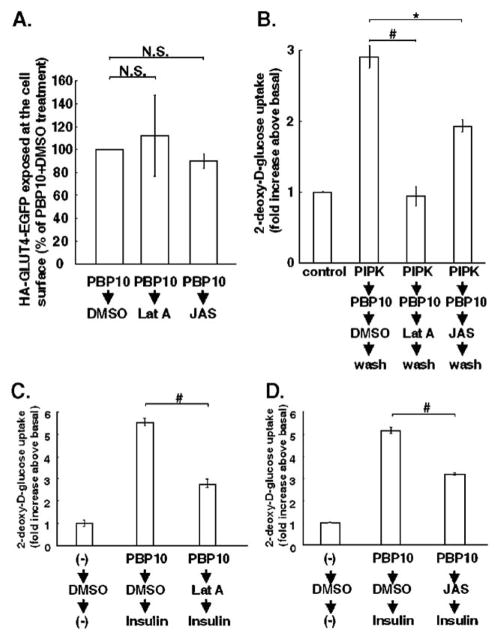Fig. 5.
GLUT4 activation requires intact F-actin remodeling. (A–B) 3T3-L1 adipocytes were electroporated with HA-GLUT4-EGFP plasmids (A) or were infected either with control adenovirus or with recombinant adenovirus for expressing human type 1α PIP-kinase (PIPK) (B). Cells were first treated with 40 μM PBP10 for 15 min to bring GLUT4 in an inactive form to the plasma membrane. Then, in the presence of PBP10, cells were treated for 30 min either with vehicle (DMSO), 20 μM latrunculin A (Lat A) to depolymerize F-actin, or 20 μM jasplakinolide (JAS) to stabilize F-actin. (A) Cells were immunostained for the HA-tag without permeation and the amount of the HA-tag exposed at the cell surface was quantified as described in Materials and methods. The amount of the HA-tag on the cell surface per the amount of EGFP expressed in each cell was counted, and the average value for cells treated with PBP10 and DMSO was set as 100%. The average value±S.E. obtained from three independent experiments, in which at least 20 cells were counted, are shown. N.S., not significant. (B) After the treatment described above, cells were washed to remove PBP10, but kept incubated either with DMSO, latrunculin A, or jasplakinolide for 20 min. 2-deoxy-D-glucose uptake was measured. Data are mean±S.E., and are expressed as fold increases of glucose uptake in control cells infected by control LacZ adenovirus and left untreated. #p<0.01; *p<0.05 C–D. 3T3-L1 adipocytes were first left untreated (−) or treated with 40 μM PBP10 for 15 min to bring GLUT4 in an inactive form to the plasma membrane. Then, in the presence of PBP10, cells were treated either with DMSO, 20 μM latrunculin A (Lat A) or 20 μM jasplakinolide (JAS) for 30 min, followed by insulin stimulation for 15 min in the presence of PBP10 and either DMSO, latrunculin A or jasplakinolide. 2-deoxy-D-glucose uptake was measured. Data are mean±S.E., and are expressed as fold increases of glucose uptake in control cells treated with DMSO only. #p<0.01. Similar results were obtained from two other independent experiments for B–D, respectively.

